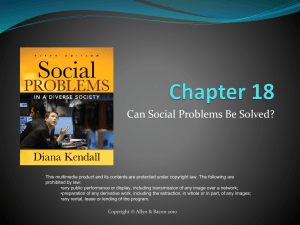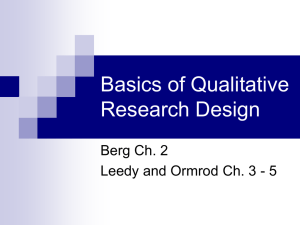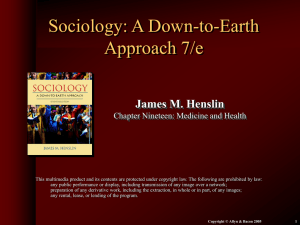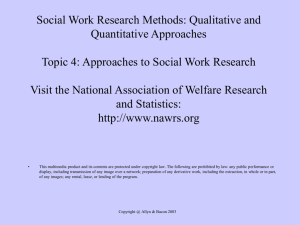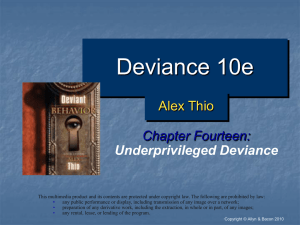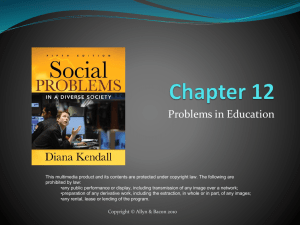Power Point document
advertisement
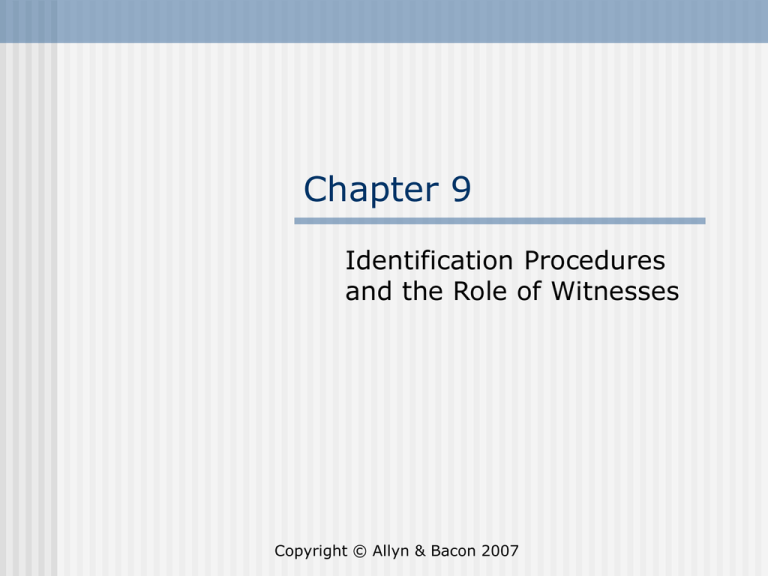
Chapter 9 Identification Procedures and the Role of Witnesses Copyright © Allyn & Bacon 2007 Introduction: Dealing with Witnesses to Crimes Identification procedures are concerned with having witnesses identify suspected criminals Three types of identification procedures are relevant: Lineup Showup Photographic array Further, identification procedures can be: Out of court (most common) In court Copyright © Allyn & Bacon 2007 I. CONSTITUTIONAL RESTRICTIONS ON IDENTIFICATION PROCEDURES Identification procedures have been challenged based on: Fourteenth Amendment due process Fifth Amendment self-incrimination Sixth Amendment right to counsel Fourth Amendment unlawful seizure Copyright © Allyn & Bacon 2007 A. Right to Counsel In United States v. Wade (1967), the Supreme Court held that the accused must be provided with counsel during post-indictment lineups Copyright © Allyn & Bacon 2007 B. Due Process In Stovall v. Denno (1967), the Supreme Court held that the accused is entitled to protection against procedures “so unnecessarily suggestive and conducive to irreparable mistaken identification” as to amount to a due process violation To avoid violating due process, the identification procedure must be: Reliable Minimally suggestive Copyright © Allyn & Bacon 2007 (continued) Factors used to determine whether an identification procedure is reliable include: Opportunity to view Witness’s degree of attention Accuracy of witness’s description Level of certainty Time between crime and identification Copyright © Allyn & Bacon 2007 C. The Fifth Amendment In United States v. Wade (1967), the Supreme Court held that the Fifth Amendment privilege against self-incrimination does not limit the use of identification procedures In other words, the Fifth Amendment doesn’t matter in the identification context Copyright © Allyn & Bacon 2007 D. The Fourth Amendment According to the Supreme Court, no one enjoys a “reasonable expectation of privacy” in characteristics that are exposed to the public Appropriate justification is necessary in order to apprehend someone for identification purposes Copyright © Allyn & Bacon 2007 E. Summary Only two constitutional provisions actually place restrictions on identification procedures. These two are the Fourteenth Amendment’s Due Process Clause and the Sixth Amendment’s right to counsel clause Copyright © Allyn & Bacon 2007 II. PRETRIAL IDENTIFICATION TECHNIQUES Now we turn attention to: Lineups Showups Photographic arrays Copyright © Allyn & Bacon 2007 A. Lineups Suspects can be forced to participate in lineups because lineups present physical characteristics, not testimonial evidence Suspects placed in lineups can also be required to supply voice exemplars, but the suspect’s use of his or her voice in this context is solely for identification purposes, not as a confession Suspects cannot refuse to participate in a lineup Consequences of refusal: Contempt Prosecutor can comment at trial on refusal Copyright © Allyn & Bacon 2007 1. Steps to Minimize Suggestiveness An overly suggestive lineup violates due process Several steps for minimizing suggestiveness have been identified in the following sources: Model Rules for Law Enforcement International Association of Chiefs of Police Examples of steps include: Lineups consisting of 5-6 people People of similar builds Suspects should choose place in line Persons known to the witness not allowed in the lineup Copyright © Allyn & Bacon 2007 B. Showups Showups are defined as one-on-one victimoffender confrontations, usually conducted outside the courtroom setting Lineups are always preferable to showups Showups are necessary sometimes Showups should not be conducted more than 60 minutes after the crime There are exceptions Copyright © Allyn & Bacon 2007 1. In-Court Showups In-court showups sometimes occur Moore v. Illinois (1977) is the leading case in this area Copyright © Allyn & Bacon 2007 C. Photographic Identification Photographic identifications involve displaying a picture of the suspect along with several other people to a victim or witness for the purpose of identification There is no Sixth Amendment right to counsel during photographic identifications Due process protections still apply Several photographs of like individuals should be shown to the witness Copyright © Allyn & Bacon 2007 III. IDENTIFICATION DURING TRIAL Oftentimes a witness will be called upon to identify the perpetrator of a crime (usually the defendant) during the trial Copyright © Allyn & Bacon 2007 A. Forms of Questions Witness questioning in a criminal trial proceeds through four stages The first is direct examination, where the witness is questioned by one party Next, cross-examination takes place. This is where the other party to the case has an opportunity to question the witness The third and fourth stages are re-direct and re-cross examination Copyright © Allyn & Bacon 2007 (continued) As a general rule, on direct examination, the questions must be “specific” but not “leading” A specific question is one that does not call for a narrative A leading question is, according to the California Evidence Code (Section 764), one “that suggests to the witness the answer that the examining party desires” Leading questions are generally impermissible on direct examination, but permissible on cross-examination Copyright © Allyn & Bacon 2007 1. Identifying a Leading Question A safe rule is that a question is leading when the question suggests an answer A question such as “You drank one beer per hole when you were golfing, didn’t you?”, is clearly leading Copyright © Allyn & Bacon 2007 2. Leading Questions during Direct Examination Leading questions are generally impermissible on direct examination Exceptions In questioning on preliminary or undisputed matters where accuracy of the witness’s response is more important than efficiency Where the witness is difficult to control without the use of leading questions (e.g., children, people with mental problems, experts, and others); For the purpose of refreshing the recollection of a forgetful witness; and Eliciting testimony from hostile witnesses Copyright © Allyn & Bacon 2007 (continued) There are two types of witness hostility: Hostility in fact and Hostility in law A witness is hostile in fact when he or she exhibits hostility toward the examiner A witness who is hostile in law is one who identifies with an adverse party Copyright © Allyn & Bacon 2007 3. Leading Questions during CrossExamination Cross-examination is commonly characterized by leading questions Leading questions on cross-examination serve the following purposes: Appeal to the conscience Awaken memories Expose inaccuracies and falsehoods Help witness focus on what is important Certain types of leading questions are impermissible on cross-examination Copyright © Allyn & Bacon 2007 4. Refreshing a Witness’s Memory Witnesses forget things To remedy this problem the Federal Rules of Evidence provide that a witness’s prior experience may be “revived” by referral to the witness’s prior statements Specific methods exists and certain steps need to be followed Copyright © Allyn & Bacon 2007 B. Witness Credibility, Impeachment, and Rehabilitation Competency pertains to a witness’s ability to remember events, communicate effectively, and understand the importance of (1) telling the truth and (b) the consequences for not doing so Credibility asks, Should the witness’s testimony be believed? When discussing competency, courts often refer to the processes or accrediting and discrediting Discrediting attacks credibility Accrediting bolsters credibility Accreditation must be preceded be efforts to discredit Copyright © Allyn & Bacon 2007 1. Impeachment Impeachment is the formal term for attacking a witness’s credibility Impeachment generally begins on crossexamination Impeachment is most often used by one party to a case against another Copyright © Allyn & Bacon 2007 2. Rehabilitation When the credibility of a witness is attacked, the side that produced the witness can take steps to bolster the witness’s credibility, either by calling other witnesses or introducing other evidence This process is known as rehabilitation Rehabilitation occurs during redirect examination Methods of rehabilitation include: Witness is telling truth now Previous statement taken out of context Other evidence to bolster credibility Copyright © Allyn & Bacon 2007 IV. THE EXCLUSIONARY RULE AND IDENTIFICATIONS When identification procedures violate constitutional protections, the results from such procedures cannot be considered admissible in a criminal trial First, if an in-court identification is tainted by an out-of-court identification, then it will be excluded Second, if a suspect is searched and/or seized improperly, then identified by a witness, the results of the identification may be excluded Copyright © Allyn & Bacon 2007 A. Tainted Identifications If the in-court identification is tainted by an out-of-court identification, it may be excluded This is known as a tainted identification In United States v. Wade (1967), the Supreme Court held that an illegally-conducted lineup does not invalidate later identifications resulting from an “independent source” Copyright © Allyn & Bacon 2007 B. Identifications Resulting from Illegal Searches and Seizures Looking at Supreme Court precedent, it would seem that identifications resulting from illegal searches and/or seizures are admissible (United States v. Crews, 1980) Further, it appears that the exclusionary rule has little “teeth” outside the Fourth Amendment context Copyright © Allyn & Bacon 2007



